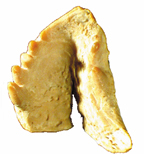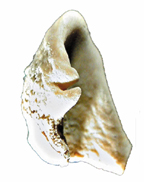Geotimes

News Notes
Paleontology
Devonian dentistry
 During
the Devonian, 350 million years ago, a group of armored fishes known as placoderms
roamed the seas. Among the largest animals of the time, they could grow to 20
feet long. Although placoderms radiated into a wide variety of ecological niches,
they survived only 50 million years, reaching a sudden and complete collapse
at the end of the Devonian.
During
the Devonian, 350 million years ago, a group of armored fishes known as placoderms
roamed the seas. Among the largest animals of the time, they could grow to 20
feet long. Although placoderms radiated into a wide variety of ecological niches,
they survived only 50 million years, reaching a sudden and complete collapse
at the end of the Devonian.
According to standard theory, placoderms lacked true teeth. Instead, bony plates,
sometimes razor-edged and self-sharpening, lined their jaws and captured dinner.
Photos courtesy
of Moya Smith.
A study in the Feb. 21 Science turns this view on its head,
indicating that an advanced group of placoderms, called Arthrodira, did have
teeth. And because Arthrodira seem to have followed an evolutionary lineage
distinct from other toothed vertebrates, it appears that teeth evolved twice
— wholly independently.
 The evidence comes
from Arthrodira fossils from the Upper Devonian Gogo Formation in Western Australia.
Well-preserved, 3-D jaws — pictured here — show patterns of true teeth:
well-ordered protrusions filled with dentine, and specific spots where new teeth
grew.
The evidence comes
from Arthrodira fossils from the Upper Devonian Gogo Formation in Western Australia.
Well-preserved, 3-D jaws — pictured here — show patterns of true teeth:
well-ordered protrusions filled with dentine, and specific spots where new teeth
grew.
The study “combines new paleontological data with developmental interpretations
of both structural patterning of teeth in a dentition and growth of individual
teeth,” says co-author Moya Smith, a professor of Evolutionary Dento-Skeletal
Biology at King’s College, London. “This is highly relevant to debate
the canonical view that teeth evolved together with jaws only once in evolution.”
Michael Coates, a paleontologist at the University of Chicago, says that placoderm
lineages have come under increasing scrutiny. It may be that Arthrodira evolved
from the same ancestor as other toothed vertebrates, undermining the hypothesis
that teeth evolved twice. Says Coates: “Without a good phylogeny of placoderm
relationships, can we be certain that the teeth are independently derived?”
Smith and colleagues plan to re-examine placoderm phylogenetics to resolve this
question.
Greg Peterson
 During
the Devonian, 350 million years ago, a group of armored fishes known as placoderms
roamed the seas. Among the largest animals of the time, they could grow to 20
feet long. Although placoderms radiated into a wide variety of ecological niches,
they survived only 50 million years, reaching a sudden and complete collapse
at the end of the Devonian.
During
the Devonian, 350 million years ago, a group of armored fishes known as placoderms
roamed the seas. Among the largest animals of the time, they could grow to 20
feet long. Although placoderms radiated into a wide variety of ecological niches,
they survived only 50 million years, reaching a sudden and complete collapse
at the end of the Devonian. 
 The evidence comes
from Arthrodira fossils from the Upper Devonian Gogo Formation in Western Australia.
Well-preserved, 3-D jaws — pictured here — show patterns of true teeth:
well-ordered protrusions filled with dentine, and specific spots where new teeth
grew.
The evidence comes
from Arthrodira fossils from the Upper Devonian Gogo Formation in Western Australia.
Well-preserved, 3-D jaws — pictured here — show patterns of true teeth:
well-ordered protrusions filled with dentine, and specific spots where new teeth
grew.